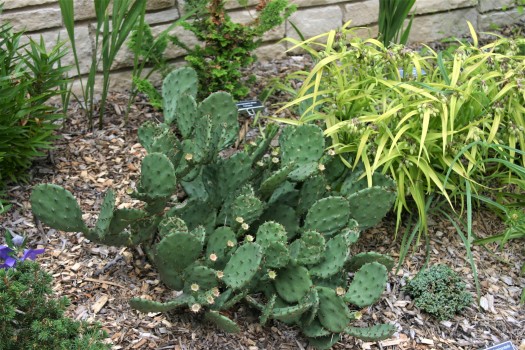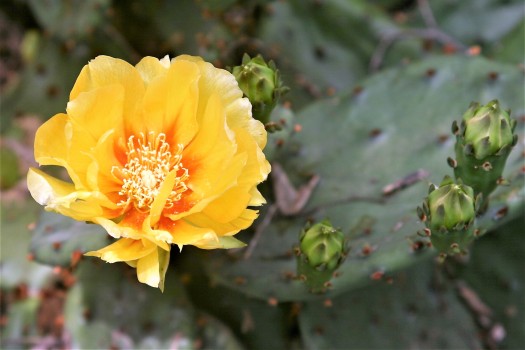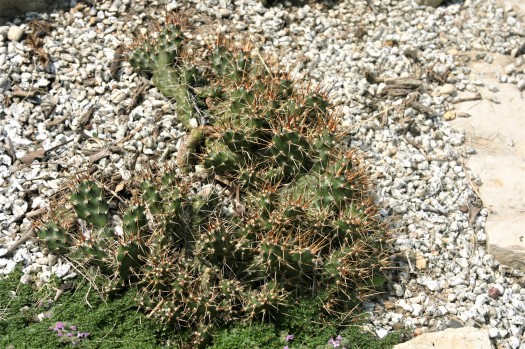Many visitors to our garden in the summer are surprised to see cacti in bloom. Inevitably they would ask, “Do you take it inside during the winter?” No we do not, in fact, two of the four species which we grow in our yard are native to Wisconsin, and another of the four came from Minnesota.
Wisconsin is host to three cacti species, all of the genus Opuntia, the prickly-pear cactus. Opuntia humifusa, the Eastern Prickly-pear, is perhaps the most common. It is found in dry sand prairies and sandstone ledges in the southwest and central counties of the state. Translated from the Greek, the name means “spreading, cactus-like plant.” Spread it does! To keep it from taking over our patio bed, we remove about a third of the flattened paddle-like leaves each year. The showy yellow flowers usually bloom in early to mid-July but. Flowers are followed by an edible red fruit, though I have never tried it in the kitchen.
Also found in the southwest and central parts of the state is Opuntia macrorhiza, the Plains Prickly-pear. It has characteristics similar to the Eastern Prickly-pear. The word macrorhiza refers to its wide-spreading roots, which allow it to absorb water from areas far from the center of the plant.
The smallest of the three native species is Opuntia fragilis, the Brittle Prickly-pear. It is found in the central sand counties of Wisconsin and along the Mississippi River to the north. The thick oval pads are rarely more than a couple of inches long, about a quarter the size of the other two species. They break off with the slightest jarring, giving rise to its common name. We grow this plant in our rock garden in almost pure sand.
Prickly pears are armed with two types of spines; large, smooth, fixed spines and small, hair like prickles called glochids, that easily penetrate your skin and detach from the plant. Though you may be careful to avoid the larger spines, I find the smaller glochids to be the most troublesome. Thick leather gloves come in handy when handling cacti!
Growing a hardy prickly pear is simple; just provide a well-drained sandy soil and as much direct sun as possible. During the winter they will often become prostrate and hug the ground, but perk up again in the spring. Propagating an Opuntia couldn’t be easier. Just break off a branch and lay it on the ground with a little sandy soil around the breakage point. Within a month or two it will have formed its own root system.
Prickly pear cacti are only native to the Americas; over 100 species of Opuntia are native to the US. Most are in the desert Southwest, but their range extends throughout the country, from the warmest to the coldest regions. Not all are hardy to the far north, however, so if you want to use one in your yard, be sure to choose a local source. It may be the answer to that sunny dry spot in your yard where nothing else will grow.




One Reply to “”